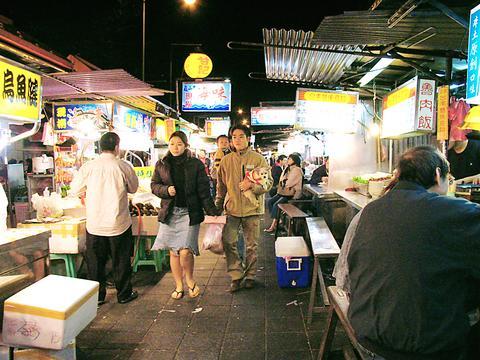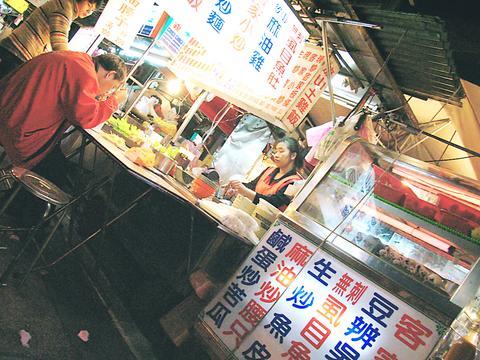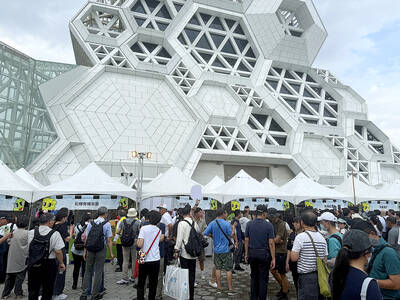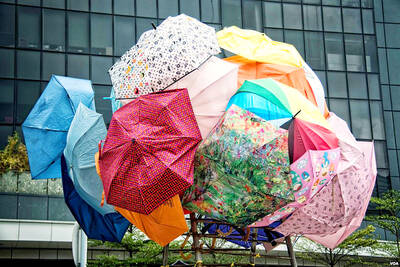For most Taipei residents, Datong District is that old part of town sandwiched between Zhongshan North Road and Sanchung. It's long been a commonly held belief that the only reason to venture that far west is if you're going to Ximending or to Dihua Street for New Year's shopping. But the area is seeing more traffic lately, especially in the wee hours, due to the newly renovated Ningxia Tourist Night Market.
While the market has been there for decades, stretched between Nanjing West and Minsheng West roads, it's only recently been given the city's official chop as a "tourist" night market. And with that designation has come a budget of millions of NT dollars aimed at improving the infrastructure of a market already famous for its Taiwanese cuisine.

PHOTO: DAVID MOMPHARD, TAIPEI TIMES
The most noticeable renovation is that all the food stalls on the west side of the road have been relocated to the center of the street, allowing scooters and cars to pass more freely in an area once congested with pedestrians. City workers spent the summer repaving the street with brickwork and laying steel-covered trenches down the length of the street which provide water and electric to vendors who once made due to with buckets and car batteries.

PHOTO: DAVID MOMPHARD, TAIPEI TIMES
"It was unsafe the way it was," said one Ms Chuang, whose fried mochi stand, like several stands along the street, bears Mayor Ma Ying-jeou's signature. "People would step out of one of the stalls and nearly be run over by a scooter. It also feels more like a night market with us all closer together like this."
Chuang had a gripe about one aspect of the renovation: "The government raised the rent."
Now that the stalls have been provided with power and water, the cost of setting up shop has risen from about NT$13,000 per month for a middle of the road space to NT$15,000. The price goes up to about NT$20,000 toward the end of the street nearest Minsheng, which gets the heaviest foot traffic.
Still, staying on the street has had a better result than the lot that's befallen proprietors of the recently completed Jincheng Circle Food Court at the south end of Ningxia Road. That glass-encased colossus,"Taipei's Halo," has bedeviled its developer and put many renters out onto the street, where the rent is less and the foot traffic is considerably greater.
"That building has bad luck," Chuang opines. "Before it was built, the developer came to all of us saying we'd go out of business if we didn't move into it because it was going to be so popular. Now the people that moved into it are going out of business or else coming back out here."
Several new food stalls have opened up shop on Ningxia in the wake of the renovations and the items available now include Japanese-style fried octopus balls, duck meat hand-wraps, sushi, and enough juice stands to flood the street. Many of the items are considered exotic for a night market famous for its fried oyster omelets and cold chicken dishes. There is also a whole new row of games with plastic-wrapped plush dolls waiting to be won.
But with the fresh faces has come fresh competition. A fried mochi stand new to the neighborhood has Ms Chuang polishing her stainless steel cart and rethinking her signage.
"They hung a clipping from some magazine they were in and now everyone thinks their mochi is famous and lines up to try it," she said. "I need to get in a magazine!"
What: Ningshia Tourist Night Market.
When: Nightly, from about 6pm to 2am.
Where: Ningshia Road, between Minsheng West and Nanjing West roads, west of Chengde Road (寧夏路,民生西路和南京西路之間).

Water management is one of the most powerful forces shaping modern Taiwan’s landscapes and politics. Many of Taiwan’s township and county boundaries are defined by watersheds. The current course of the mighty Jhuoshuei River (濁水溪) was largely established by Japanese embankment building during the 1918-1923 period. Taoyuan is dotted with ponds constructed by settlers from China during the Qing period. Countless local civic actions have been driven by opposition to water projects. Last week something like 2,600mm of rain fell on southern Taiwan in seven days, peaking at over 2,800mm in Duona (多納) in Kaohsiung’s Maolin District (茂林), according to

Aug. 11 to Aug. 17 Those who never heard of architect Hsiu Tse-lan (修澤蘭) must have seen her work — on the reverse of the NT$100 bill is the Yangmingshan Zhongshan Hall (陽明山中山樓). Then-president Chiang Kai-shek (蔣介石) reportedly hand-picked her for the job and gave her just 13 months to complete it in time for the centennial of Republic of China founder Sun Yat-sen’s birth on Nov. 12, 1966. Another landmark project is Garden City (花園新城) in New Taipei City’s Sindian District (新店) — Taiwan’s first mountainside planned community, which Hsiu initiated in 1968. She was involved in every stage, from selecting

The latest edition of the Japan-Taiwan Fruit Festival took place in Kaohsiung on July 26 and 27. During the weekend, the dockside in front of the iconic Music Center was full of food stalls, and a stage welcomed performers. After the French-themed festival earlier in the summer, this is another example of Kaohsiung’s efforts to make the city more international. The event was originally initiated by the Japan-Taiwan Exchange Association in 2022. The goal was “to commemorate [the association’s] 50th anniversary and further strengthen the longstanding friendship between Japan and Taiwan,” says Kaohsiung Director-General of International Affairs Chang Yen-ching (張硯卿). “The first two editions

It was Christmas Eve 2024 and 19-year-old Chloe Cheung was lying in bed at home in Leeds when she found out the Chinese authorities had put a bounty on her head. As she scrolled through Instagram looking at festive songs, a stream of messages from old school friends started coming into her phone. Look at the news, they told her. Media outlets across east Asia were reporting that Cheung, who had just finished her A-levels, had been declared a threat to national security by officials in Hong Kong. There was an offer of HK$1m (NT$3.81 million) to anyone who could assist